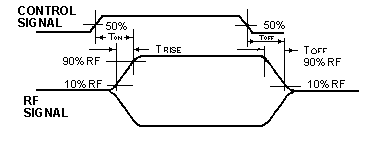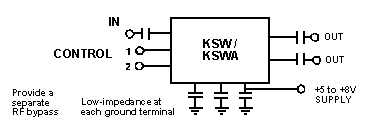Switches
A wide variety of PIN diode and GaAs high-speed, high-isolation switches are available from Mini-Circuits, including models with built-in TTL drivers, operating up to 5 GHz. Select from SPST, SPDT, and SP4T models in EMI-shielded plug-in, TO-8, surface-mount and connectorized packages.
PIN diode units are available in SPST/SPDT configurations as well as SPDT/SP4T models with built-in drivers with 2 µsec switching speed, tough enough to pass stringent MIL-STD-202 tests. Despite their small size, the TO-8 models (TOSW-230 and TOSW- 425) provide isolation as high as 40 dB, only 1.1 dB insertion loss, with a 1dB compression point of +27 dBm.
Switching speed as fast as 2 nsec is offered with Mini-Circuits GaAs switches, available in
absorptive and reflective models, with and without TTL built-in drivers. All models are available
with SMA connectorized or surface-mount packages. The connectorized packages are miniature,
easily mountable, and well suited for test set-ups. Surface-mount units are offered in a low-cost
plastic package and hermetic ceramic cases for military applications. These packages are rugged
enough to pass MIL-STD-883 vibration, mechanical and thermal shock, fine and gross leak tests.
These fast-acting switches can operate from DC up to 5 GHz with 50dB isolation and only 1 dB
insertion loss. The absorptive models exhibit a typical VSWR of 1.5 in the "OFF" state.
Modern Definition of Terms
insertion loss
The insertion loss is the attenuation between input and output ports of the switch when embedded in a circuit, when the switch control voltage corresponds to the "ON" state of the output port. For insertion loss measurement techniques see section O of the hand-book.isolation
The isolation is the attenuation between input and output ports of the switch when embedded in a circuit, when the switch control voltage corresponds to the "OFF" state of the output port. See insertion loss measurement techniques in Section O of the hand-book.vswr
VSWR (Voltage Standing Wave Ratio) indicates the degree of impedance match present at the switch RF port. In most cases, it is much easier to describe the impedance match in terms of return loss, dB. Return loss is equal to the amount of reflected power relative to the incident power at a port. Simply by measuring both incident and reflected power, the return loss can be measured and hence the VSWR can be calculated. For return loss measurements see section O of the handbook. For convenience, a conversion chart between VSWR and Return loss is given in section O.transients
During switching, video transients occur which can disturb RF components following the switch. If lower transients are critical during the switching period, use a slower transition rate between control states.noise figure
Noise Figure (N.F.) of a switch is considered equal to its insertion loss.1 dB compression point
The RF input power level at which the switch insertion loss increases by 1 db over its low-level value.switching speed
The most popular parameters are listed below:

TRise = Rise Time, time for RF signal to rise from 10% to 90% of the "on" level.
TFall = Fall Time, time for RF signal to fall from 90% to 10% of the "on" level.
TOn = On Time, time from 50% of the control pulse to 90% of the "on" level.
TOff = Off Time, time from 50% of the control pulse to 10% of the "on" level. Rise time and fall
time affect the upper limit of switching rate and dictate the minimum time necessary for the
switch to change state. On or Off time measures the total switching time starting at control pulse
transition (50% point) to RF level stabilization (90% or 10% point). Switching speed is defined
as the greater of these two values.
Most Often Asked Questions About Switches
Q. What is the difference between an absorptive and a reflective switch?A.
In a reflective switch, the impedance of the port that is OFF will not be 50 ohms and will have a very high VSWR. On the other hand, an absorptive switch will have a good VSWR on each port regardless of the switch mode.Q. Instead of working with one input and two outputs, can I use the switch in the opposite
direction? I want to connect signals to the "output" ports and use the "input" as the output
port.
A.
Q. When should I use an absorptive switch? A reflective switch?
A.
Q. What is the difference between PIN diode switches and GaAs switches?
A.
A PIN diode switch is more tolerant of high peak power when using pulsed RF input, being limited mainly by average dissipation; power rating of a GaAs switch is determined more by internal peak voltage and current ratings. On the other hand, GaAs switches are faster, switching ON and OFF in a few nanoseconds compared with microseconds for PIN switches. Also, GaAs switches have RF response extending down to DC, whereas in PIN switches there is a practical lower limit to the frequency range in which the diodes behave as linear resistors. Finally, switching-signal (video) leakage into the RF ports is lower in GaAs switches by a factor of 10.
Q. I see that the MCL KSW and YSW series are specified down to DC. Will they actually work
with DC voltage?
A.
Q. I am working with a KSW/KSWA switch. Can I connect the switch to work on +V instead of -V?
A.
Q. I only have -5V, not -8V. Will the KSW/ KSWA work with -5V and what will the effect be?
A.
Q. I want to use the switch as a modulator. What is the maximum modulating frequency I can
use?
A.
Where Ton and Toff are defined below under "switching speed." A precaution: in modulator service
the maximum allowable RF input power for the KSW/KSWA/KSWHA switches is reduced as
follows:
-
Up to 200 MHz : reduce by 10 dB
200 to 2000 MHz : reduce by 6 dB
Above 2000 MHz : reduce by 5 dB
Q. When I use the switch as a modulator, how much leakage (video break-through) of the
modulating signal will appear at the output?
A.
Q. I am using a switch to alternate between two generators. What is the isolation between the
two inputs?
A.
Q. What is the peak power limit a Mini-Circuits' switch can handle?
A.
Q. Are Mini-Circuits' switches bi-directional?
A.
Q. Is the output of a switch open-circuit or closed-circuit in the "OFF" state?
A.
Q. What can happen when a switch is driven into compression?
A.